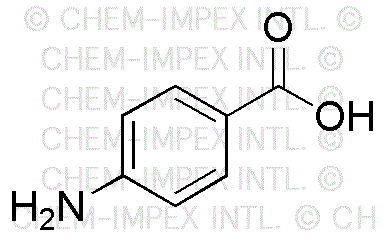4-Aminobenzoic acid is widely utilized in research focused on:
- Pharmaceutical Development: It serves as a precursor in the synthesis of various pharmaceuticals, particularly in the formulation of local anesthetics like procaine, enhancing pain management options.
- Cosmetic Industry: Commonly used in sunscreen formulations, it helps absorb UV radiation, providing effective skin protection and improving the stability of cosmetic products.
- Biochemical Research: Acts as a growth factor for certain bacteria and is used in microbiological studies, aiding researchers in understanding microbial growth and metabolism.
- Polymer Chemistry: Employed in the production of dyes and pigments, it contributes to the development of high-performance materials with vibrant colors, useful in textiles and coatings.
- Analytical Chemistry: Utilized as a reagent in various analytical techniques, it helps in the detection and quantification of other compounds, streamlining laboratory processes.
General Information
Properties
Safety and Regulations
Applications
4-Aminobenzoic acid is widely utilized in research focused on:
- Pharmaceutical Development: It serves as a precursor in the synthesis of various pharmaceuticals, particularly in the formulation of local anesthetics like procaine, enhancing pain management options.
- Cosmetic Industry: Commonly used in sunscreen formulations, it helps absorb UV radiation, providing effective skin protection and improving the stability of cosmetic products.
- Biochemical Research: Acts as a growth factor for certain bacteria and is used in microbiological studies, aiding researchers in understanding microbial growth and metabolism.
- Polymer Chemistry: Employed in the production of dyes and pigments, it contributes to the development of high-performance materials with vibrant colors, useful in textiles and coatings.
- Analytical Chemistry: Utilized as a reagent in various analytical techniques, it helps in the detection and quantification of other compounds, streamlining laboratory processes.
Documents
Safety Data Sheets (SDS)
The SDS provides comprehensive safety information on handling, storage, and disposal of the product.
Product Specification (PS)
The PS provides a comprehensive breakdown of the product’s properties, including chemical composition, physical state, purity, and storage requirements. It also details acceptable quality ranges and the product's intended applications.
Certificates of Analysis (COA)
Search for Certificates of Analysis (COA) by entering the products Lot Number. Lot and Batch Numbers can be found on a product’s label following the words ‘Lot’ or ‘Batch’.
*Catalog Number
*Lot Number
Certificates Of Origin (COO)
This COO confirms the country where the product was manufactured, and also details the materials and components used in it and whether it is derived from natural, synthetic, or other specific sources. This certificate may be required for customs, trade, and regulatory compliance.
*Catalog Number
*Lot Number
Safety Data Sheets (SDS)
The SDS provides comprehensive safety information on handling, storage, and disposal of the product.
DownloadProduct Specification (PS)
The PS provides a comprehensive breakdown of the product’s properties, including chemical composition, physical state, purity, and storage requirements. It also details acceptable quality ranges and the product's intended applications.
DownloadCertificates of Analysis (COA)
Search for Certificates of Analysis (COA) by entering the products Lot Number. Lot and Batch Numbers can be found on a product’s label following the words ‘Lot’ or ‘Batch’.
*Catalog Number
*Lot Number
Certificates Of Origin (COO)
This COO confirms the country where the product was manufactured, and also details the materials and components used in it and whether it is derived from natural, synthetic, or other specific sources. This certificate may be required for customs, trade, and regulatory compliance.


